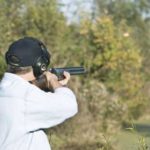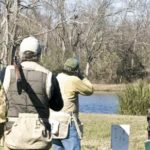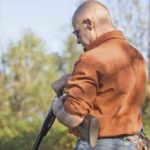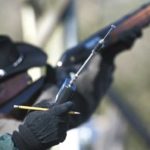
Hone your wing-shooting skills and bag more birds next season by giving sporting clays a try.
Many ranges use remote controlled traps, which allows machines to be placed in the distance and in front of the shooters, allowing for endless variety and realistic hunting scenarios. The shooter calmly mounted the shotgun to his shoulder. Two birds streaked low in front of him as though they we’re about to land in the pond.
He swung the barrel behind and through them with the calm, deliberate attitude of a seasoned hunter. He fired once, then again.
The shooter cracked open the breach on his over/under. Two spent and smoking 12-gauge shells fell to the ground.
“Two dead birds,” his partner remarked.
The shooter loaded two more rounds into the barrels, and readied himself for the next pair of birds.
Most hunters might imagine this scene taking place in a typical duck blind or while walking through a dove field.
On this day, however, it was taking place at a sporting-clay range just south of Bell Chasse.
The ‘birds’ were in fact 4¼-inch orange clay disks. And while you can’t dress them for the kitchen table, there’s a certain satisfaction that comes from watching them explode into a thousand tiny pieces.
Don’t put that shotgun away just yet.
March 9 marks the closing of the light geese conservation season in Louisiana. For residents, it’s the last chance to take aim at winged creatures until the September teal season opens.
Instead of leaving that shotgun in the gun rack for the next six months, take up a new sport that will improve your aim and help you bag more birds next season.
When most sportsmen hear “sporting clays,” they mistakenly think of skeet or trap.
While all three sports use shotguns and clay targets, the similarities end there.
Unlike trap and skeet, which use known distances and regimented setups, sporting clays is designed to mimic real-life hunting situations.
Most sporting-clay courses range from 10 to 14 stations over a 10- to 30-acre site. On many courses, the trap machines are completely hidden from the shooter’s view.
A typical round of clays consists of 50 to 100 shots per shooter.
Multiple sizes and colors of clays are used. Trap machines are set up to recreate, as closely as possible, the same conditions and situations you would find in hunting.
Some clays fly straight up over you, much like real teal. Others might pop up from the brush like quail. Some actually come out of the tops of trees. There are even clays, called ‘rabbits,’ that bounce along the ground in front of you.
Unlike trap and skeet, the rules not only allow for — but encourage — each course to be laid out differently. Most course owners will even change the position of the trap machines and the type of shots from week to week.
Paul “Hawk” Hawkins, manager of the GOL Shooting Center in Maurice, has been shooting at clay targets since the early 1990s.
“You need to know how to shoot a little bit of everything to be good at clays,” he said. “Every club is just like a golf course. Every course is different no matter where you go.
“Whatever region you’re in, figure out what their favorite game birds are, and those are the kinds of targets you’re going to see.
“In northern Louisiana, you might see a lot of woodcock. In southern Louisiana you’ll see a lot more waterfowl.”
According to Sere Russell, president of the Louisiana Sporting Clays Association (LSCA), variety is the name of the game.
“Trap and skeet both use known speed and known distances,” he said. “Both of those sports are about perfection. You need to be able to repeat the same shot over and over.
“In sporting clays, you have an infinite variety of targets. And every tournament is different. That’s what shooters want.”
The variety actually helps a shooter hone his hunting skills.
“The timing of the targets and the number of shots one takes changes from to station to station,” explains Don Vallee, owner of High Point Shooting Range in Belle Chasse. “A shooter can only have two rounds loaded in his gun at a time.
“Some stations are ‘singles,’ where only one bird is presented. The shooter can shoot both rounds at him. Others are what are called ‘report pairs.’ On a report pair, one bird shows, and the person pulling the targets doesn’t release the second one until he hears the report of the gun.
“The toughest pair is what is known as a ‘true pair.’ On a true pair, both clays are released at the same time. The shooter has to react quickly and take one shot at each. The clays can come from anywhere. You might have one high and one low, one coming toward you and one going away. It’s really tough.
“When you first come to the station, you are allowed one look. You pull the targets once, and everyone has to pay attention.”
Another rule that adds hunting realism is that shooters are not allowed to mount the gun until they see the first bird.
“When’s the last time you saw a hunter standing around waiting with his gun tucked up into his shoulder?” Vallee asked. “Learning to mount your shotgun with consistency so it goes to the same place every time is key.”
This is a big part of the attraction for hunters.
“There’s no doubt that clays makes you a better hunter, and I can tell you from my personal experience,” Russell said. “I’ve been traveling to hunt doves in South America since the early 1990s. “Down there, they keep a record of how many shells you shoot and how many doves you drop.
“I was shooting a 20-guage back then, and I was getting something like 37 percent. Well, I went to Argentina last summer, and I shot a 28-gauge, and I shot something like 74 percent.
“The difference is I shot a whole lot of clay targets over the years, and it’s made me a better hunter. I have a whole lot better understanding of how to push a gun in front of a bird, how to follow through and how to make him fall. That’s the only way to successfully bird hunt.”
Hawkins also commented on the benefits of practicing on sporting clays.
“It helps you focus,” he said. “Although these targets require a lot more perceived lead than any duck ever will, it gets you practiced in mounting the gun on your shoulder, looking at a bird and allowing your hands to go to where that bird is.
“After a while, you don’t need to think about it. It just becomes a matter of focus. That equals more birds out in the field.”
Many hunters mistakenly think shooting sporting clays is all about competition.
“You don’t need to compete in tournaments to shoot sporting clays,” says Vallee. “Anyone can just show up and shoot.”
Most ranges in the state are open to the public on most weekends. You also don’t need to be a member of the LSCA to shoot in a tournament if they happen to be having one. They have a hunter class that anyone can enter.
And don’t let the sport’s double-barrel European roots scare you off.
“You don’t need a fancy over/under gun,” says Vallee. “There are guys who show up with pump-action Winchesters and shoot well; there are other guys who show up with thousand-dollar guns, and don’t shoot so well. This sport has its roots in hunting, and you can use the same types of guns that you hunt with.”
According to Vallee, 12-gauge shotguns are the most popular, but you can shoot any gauge. This means you can bring your son, daughter or wife to the range, and make it a family affair.
Hawkins believes the sport needs more families.
“The sport of sporting clays in Louisiana is getting bigger and bigger every year,” he said. “I would like to see more mothers and more children.”
“We try to make it fun for everybody,” says Russell. “I went to a tournament this weekend, and we a saw a college-aged young man and his girlfriend. He was by himself, and his girlfriend was trapping and scoring for him.”
However, Russell does make the point that if you want to compete, Louisiana is a good place to do it.
“We invited him and his girlfriend to ride with us and shoot on our squad,” he said. “That’s what we aim to do. We want to get people involved in the game. He had a good time, and she seemed to enjoy it more as she learned more about the game. Every time I can, I’m going to get a new shooter out there and get him shooting with me.”
There are certainly enough opportunities.
“Last year we had 60 registered shoots,” Russell said. “We had four ‘big blasts,’ which are multi-day shoots, including the Mardi Gras Shoot, which is a shoot we’ve had for about five years now. Its become a nationwide, well-known shoot. All the big guns from all over the country come to shoot it.
“So far this year, we have 64 registered shoots on the calendar. Last year we had nine clubs throwing shoots; this year we have a 10th.
“This year we also have the Browning-Briley Shoot, which has been in Houston for the last 10 or 12 years. This is a big thing for Louisiana. It’s about 400 shooters every year. They are going to combine that shoot with the annual Mardi Gras Shoot.”
Also coming to Louisiana this year is the U.S. Open.
“The U.S. Open rotates around the country to different big clubs that can handle it,” Russell said. “The last time it was in the south was in 2004 when it was in Houston. This year it’s coming to Cajun Elite Shooting Center in Jennings. Around 1,100 to 1,300 shooters come to this shoot, which makes it the second-biggest tournament in the nation. All your top guns will come. There will be shooters from other countries coming. It’s going to also have a big economic impact on Louisiana.”
The U.S. Open will run from May 27-June 1.
A way that many people get started in sporting clays is by participating in a charity or corporate tournament.
“Virtually all of the clubs have fundraiser and benefit shoots,” Russell said. “You can learn to do tournaments this way with sort of a low stress level and some softer targets than you might find at a registered shoot.”
There are already six charity shoots on the calendar for this year, and Russell believes there will be even more.
Speaking of charities, the LSCA itself does its own share of good works. Using proceeds from shooter fees at registered shoots, the organization provides a collage scholarship.
“We decided last year to provide a four-year $6,000 college scholarship to a shooter,” Russell said. “One of the main ways that you qualify is by the number of Louisiana tournaments you enter and shoot.”
With the U.S. Open in Louisiana this year, Russell hopes to generate even more proceeds and increase the number of scholarships they can award.
The LSCA also found a way to help the rest of Louisiana’s shooters out.
“Because sporting clays is just booming,” Russell said, “we were able to provide a $50 rebate off their entry fee to all Louisiana Shooters who entered the main event in the state tournament last year.”
Russell hopes to expand the number of rebates this year and encourage even more residents to participate.
Private corporate shoots are another growing aspect of the sport. Are you looking for a new way to entertain a large group of clients? Do you want to something different for your next company BBQ?
“Virtually all of the clubs in the state hold corporate events,” Russell said.
GOL Shooting Center, one of the two private membership clubs in the state, even has a corporate membership program.
At the High Point Shooting Range, Vallee entertains several large corporate groups a year.
“The corporate shoots and fundraisers are really the only way to maintain our business,” he said.
If you’ve been shooting sporting clays for a while and think your ready for a new challenge, consider FITASC.
FITASC (Federation Internationale de Tri Aux Armes Sportives de Chasse for our French speakers) is generally considered the most challenging form of sporting clays. It is the French version of field shooting.
The rules are a little stricter. Like the American version, six sizes of clays are used. Great variety and lack of repetition is accomplished by the use of a number of traps. The targets are generally faster and fly farther.
To call Vallee a FITASC enthusiast is an understatement. His High Point Shooting Range contains everything necessary to create the most difficult of FITASC courses.
Fortunately for him, he’s not alone. Vallee has a small cadre of regulars who gather at his range on Saturdays to keep their skills sharp.
Recently, a group of 75 United States Marines stationed in New Orleans got together in their off-duty time to hold the first of what they hope will be several tournaments a year.
Marine Major Brian Hormberg, stationed at Marine Forces Reserve Headquarters in New Orleans, started off shooting skeet and trap when he was 16. Later, while stationed in Jacksonville, N.C., he began shooting sporting clays.
The Marines stationed in New Orleans support Marine Corps reservist training all across the country. For this reason, they do not get to spend as much time as they would like in the field honing their shooting skills.
Hormberg, after hearing his general wanted to find a way to improve the Marines’ shooting skills and socialize at the same time, stepped up to the plate.
“Shooting sporting clays can help us to learn to shoot moving targets more accurately,” Hormberg said. “This is something that our commander wants.”
Marines’ participation in the tournaments is voluntary.
“The feedback from the Marines who participated was overwhelmingly positive,” Hormberg said.
It was so positive that Hormberg is working on setting up another tournament for the Marines in March. His commander would like to see it grow into a quarterly event.
To learn more about sporting clays, find a range or see the calendar of registered tournaments and benefit shoots, log on to www.lsca.info.







